Mad Hedge Biotech and Healthcare Letter
April 4, 2023
Fiat Lux
Featured Trade:
(IN IT TO WIN IT)
(HUM)

Mad Hedge Biotech and Healthcare Letter
April 4, 2023
Fiat Lux
Featured Trade:
(IN IT TO WIN IT)
(HUM)

If you want to increase your chances of success in the stock market, forego complex formulas and algorithms. The process does not have to be rocket science. Instead of a complicated equation, remember the age-old saying, “Keep it simple.”
That means you should choose companies whose products and services make up the backbone of our economy, such as healthcare, technology, and energy.
Investing in healthcare stocks can offer a safe haven for your portfolio, no matter the economic climate. These essential goods and services are always needed by patients, so it pays to explore quality investments that will stand up over time.
Quality healthcare stocks can provide a reliable means for investors to capitalize on growing markets, and the insurance sector is an especially noteworthy opportunity.
As the world's population ages and healthcare costs continue to soar, health insurance is rapidly becoming a crucial necessity. That's why experts project a steady 7.1% annual increase in global health insurance industry revenue. By 2028, they project that revenue will have surged to nearly $2.6 trillion, up from $1.7 trillion in 2022.
These statistics underline the growing importance of investing in the health insurance sector, as it continues to expand and offer promising growth opportunities.
When it comes to capitalizing on the promising growth prospects in the health insurance sector, Humana (HUM) is a heavyweight contender.
Humana's roots date back to 1961 when it was founded in Louisville, Kentucky. Today, it stands tall as one of the largest insurance companies in America. Its specialty lies in providing government-subsidized plans, catering to Medicare Advantage, Medicaid, and Tricare (for the military).
With over 22 million members enrolled in its various plans, including medical, dental, and vision coverage, the company is well-positioned to reap the benefits of this burgeoning industry.
In fact, with a market capitalization of $64 billion, Humana is currently the fifth-largest health insurer globally.
As the demand for health insurance continues to grow, Humana's strong market position and broad range of offerings make it a compelling option for investors looking to tap into the sector's potential.
Humana's Q4 performance was a sight for sore eyes for investors, with revenue up 6.6% YoY to $22.4 billion. The company's medical membership grew by 0.1%, reaching 17.1 million, boosted by a 3.2% growth in Medicare Advantage membership.
Coupled with premium hikes, this led to an upward trend in Humana's revenue. The cherry on top was the non-GAAP diluted EPS of $1.62, reflecting a staggering 30.6% YoY growth rate.
Humana has a bright future ahead thanks to organic membership growth and strategic acquisitions.
Analysts predict the company's adjusted diluted EPS will compound at a rate of 14.3% annually over the next five years, outpacing the industry average of 12.4%.
While Humana's current 0.6% dividend yield may seem low compared to the S&P 500's 1.6%, the quarterly dividend per share has tripled over the last decade to $0.7875.
Plus, with a payout ratio of just 12% in 2022, there's plenty of room for future dividend increases. This means Humana can continue to invest in the business and strengthen its balance sheet while also rewarding shareholders.
If you're looking to get a real return on your investment, make sure Humana is in the mix.
With the company's growth prospects well above the industry average, this means that the stock is currently undervalued and is a prime candidate for those looking for some solid growth potential. So if you're in it to win it, now is the time to consider adding Humana to your portfolio.
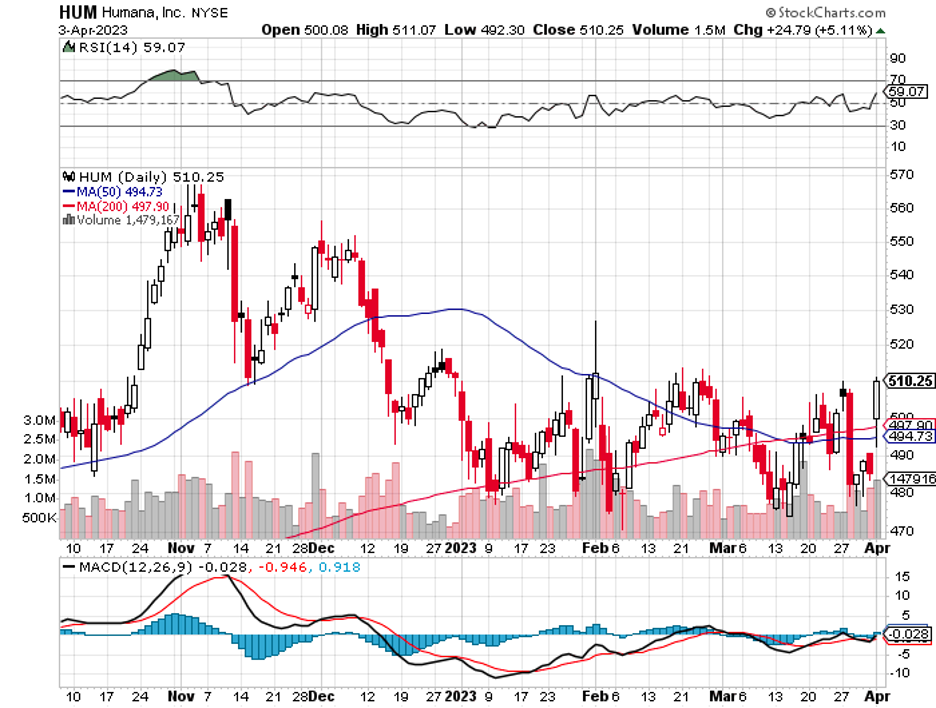
Mad Hedge Biotech and Healthcare Letter
March 23, 2023
Fiat Lux
Featured Trade:
(OLD BUT GOLD)
(HUM), (UNH)

The entire point of investing is to place your hard-earned cash to work for you, hoping that one day you will no longer need to work just as hard. A growth investing strategy could deliver just that when executed correctly and offered sufficient time.
Choosing stocks that can survive and even thrive in just about any type of economic environment is typically a critical contributing aspect to the success of an investment strategy. While daunting, this step doesn’t need to be complicated. Investors simply need to focus on picking stocks under sectors of the economy that are vital.
Healthcare is one of the sectors that constantly perform well regardless of the turmoils happening across the globe. This is because patients depend on the goods and services this industry offers at all times.
Narrowing it down some more, the segment in the healthcare world that should be taken into consideration when selecting stocks is the health insurance sector.
The health insurance industry worldwide is projected to grow by 7.1% every year from an already whopping $1.7 trillion in 2022 to approximately $2.6 trillion by 2028.
For companies like Humana (HUM), focusing on older patients is a crucial strategy in dominating this sector.
To date, Humana has roughly 22.3 million members enrolled in its medical, vision, dental, and supplemental programs, ensuring that the company can sustain its operations and still have room to expand. This company has an impressive $64 billion market capitalization, ranking it as the fifth biggest health insurer in the world.
Humana’s pièce de rèsistance is Medicare Advantage. The plans provide seniors with sets of bundled benefits and charge a handful of out-of-pocket payments.
This segment generated around $73 billion in sales last 2022, with the insurance premium offerings comprising over 84% of the company’s revenue. The remaining 16% comes from its newly launched CenterWell platform, which offers pharmacy, home care, and primary care services to seniors. In terms of revenue, these figures put Humana in second place behind UnitedHealth Group (UNH).
Even considering the potential slowdown in adding new members, the sheer number of patients signing up for Medicare Advantage most likely won’t. At the moment, about 30 million of the total 60 million seniors in the United States alone subscribe to the plans, with the other 30 million anticipated to sign up eventually. On top of that, the number of senior patients is expected to keep climbing to reach 95 million by 2060.
Despite the incredible potential of this segment, Humana has more to offer than simply Medicare Advantage.
The health insurer is ramping its CenterWell venture by acquiring more physician practices. In 2022, the number of primary-care units handled by the company rose to 235 from the 206 centers recorded in 2021. Humana collaborates with them in searching for low-cost, reliable options for patients. This strategy is a win-win for both parties.
Although it’s still a tiny business compared to Humana’s Medicare Advantage system, the figures from the CenterWell segment look promising. In the fourth quarter of 2022, it reported $4.1 billion in sales with an operating margin of 6.4%. That’s beyond the health insurer’s anticipated margin for 2023, which was set at roughly 4.8%.
As CenterWell expands in terms of how much it contributes to Humana’s total, the company’s operating margin is predicted to grow to about 5.2% by 2026. This would indicate approximately 14% annual earnings per share growth through 2026.
Humana’s 0.6% dividend yield is a potential turnoff factor, which pales compared to the S&P 500’s 1.6%. Still, this isn’t necessarily bad if given the proper context. Over the past 10 years, Humana’s quarterly dividend paid per share has continuously tripled.
This is a promising indication, especially since the dividend payout ratio of Humana was only 12% in 2022. Hence, the company has nowhere else to go but up. This is because offering a conservative payout enables Humana to maximize its funds and focus on growing the business and strengthening its balance sheet. That’s clearly why the health insurer should have no problems delivering double-digit dividend boosts within the next few years.
Overall, Humana is a demonstrably excellent company, but the stock remains underrated. I suggest you exploit the market’s disinterest in this profitable business and buy the dip.
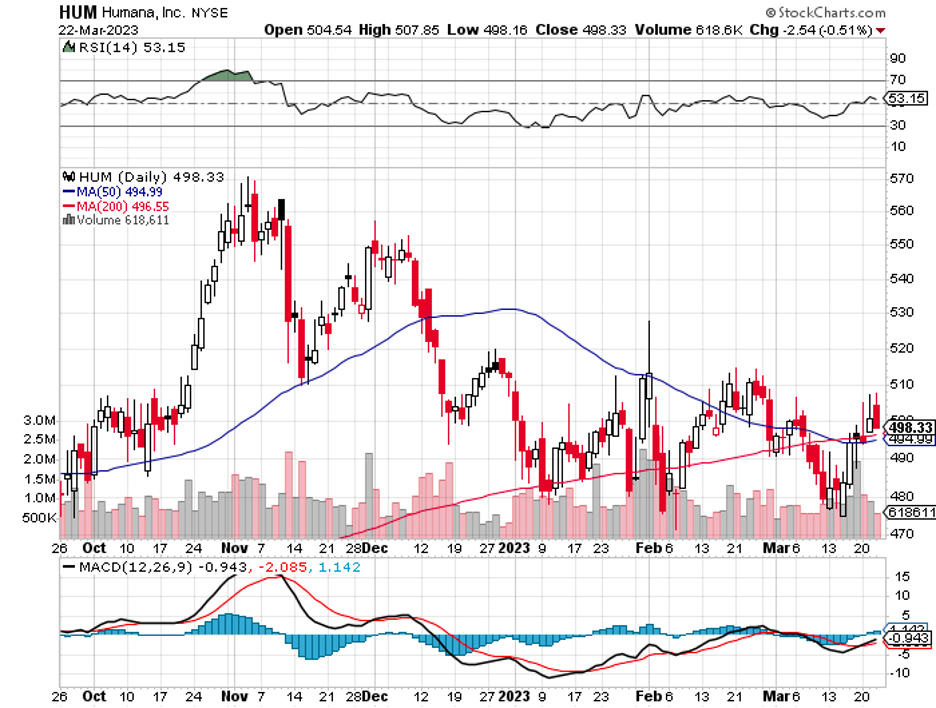
Mad Hedge Biotech and Healthcare Letter
December 8, 2022
Fiat Lux
Featured Trade:
(THE MASTODON OF HEALTHCARE)
(UNH), (HUM), (CI), (ELV), (CVS)

Most earnings reports across all industries recently include the terms “inflationary pressures,” “short-term macroeconomic conditions,” “labor shortages,” and, of course, “supply chain issues” to justify why revenues are down or flat. The S&P 50 index has declined by over 20% to date, with signs of sliding further.
Clearly, the economy cannot be described as recession-proof. It typically follows a relatively predictable, albeit irregular, path commonly called the economic cycle. Needless to say, recessionary periods can be heartbreaking and brutal for the market and its investors.
However, some sectors are somewhat immune to the ups and downs of the economy. These industries provide investors with recession-proof stocks that can be held onto during these challenging periods. One of them is the healthcare industry.
Healthcare stocks, particularly high-quality businesses, tend to be viewed as recession-proof. Despite the economic turbulence, companies in this sector still enjoy relatively solid and steady demand. That’s not entirely shocking since people can’t exactly just cancel their healthcare needs.
No matter what’s happening in the world, when you’re unwell, you have no other option but to see a doctor and get medicine.
Within the healthcare sector, not all businesses are created equal. Some still felt the recession's nasty consequences, while others managed to thrive.
One name that continues to impress amid the economic turmoil is UnitedHealth Group (UNH).
Basically, UNH operates 2 main segments.
One is UnitedHealthcare, which offers a complete range of healthcare insurance. The other is Optum Health, which provides data-driven healthcare gathered from partner surgery centers. It also obtains information from OptumRx, UNH’s pharmacy management arm.
Both UnitedHealthcare and Optus Health delivered excellent results to date, boosting the company’s full-year guidance from $20.85 to $2105 in terms of EPS. In comparison, UNH recorded an annual EPS of $18.08 back in 2021.
In the first 9 months of 2022, UNH raked in $192.5 billion in revenue. This shows a 14% increase year over year. Meanwhile, its earnings per share climbed to $16.15 compared to the $13.82 it reported during the same period in 2021.
One of the key drivers for these results is the boost in the number of subscribers to UNH’s services, which rose by 850,000 in 2022. Apart from these, the company has an attractive dividend that keeps investors satisfied. For the 13th consecutive year, UNH has raised its dividend, announcing a quarterly boost of 14% to reach $1.65.
Keep in mind that the health insurance industry climbs higher each year, and COVID-19 has forced everyone to reconsider and review their perspectives towards healthcare.
On top of these, UNH’s long-term growth is supported by the inevitable: the continuous and increasingly expensive demands of an aging population. That is, the company has a massive addressable market that keeps on expanding year after year.
Looking at the trajectory of this industry, it is estimated that 73.5 million individuals will be enrolled in Medicare by 2027. This represents a 28.5% boost from the 57.2 million reported in 2017.
Due to the increasing demands in healthcare in the coming years, particularly among the aging population, spending in this segment is also anticipated to rise rapidly. In fact, healthcare spending is projected to hit $6 trillion annually by 2028.
Thus far, UNH is hailed as the leading company in healthcare. The company’s hegemony looks and feels incomparable, and none of its competitors appear to be strong enough to dethrone it. For context, the leading rivals of UNH in the US include Humana (HUM), Cigna (CI), Elevance (ELV), and CVS Health (CVS).
For these competitors to stand a chance at beating or at least competing with its on equal grounds, they would need to merge—a move they’ve all attempted in the past but were blocked by regulators.
Overall, UNH remains a solid choice, especially during these trying times. This company is a widely respected mastodon in the insurance market worldwide, showing off substantial growth in revenue and profit practically every year. Buy the dip.
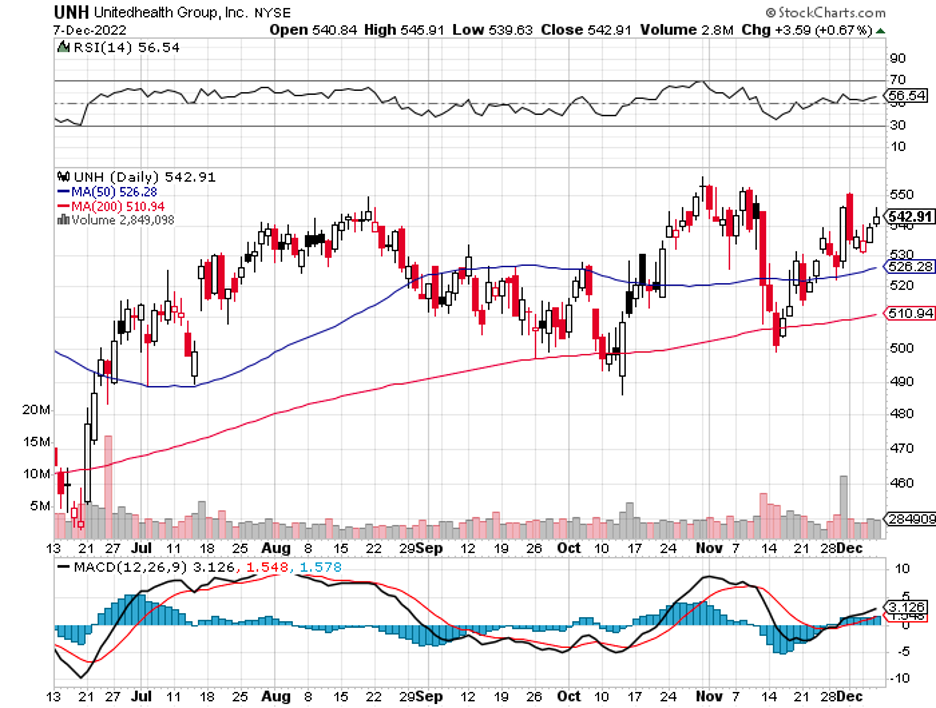
Mad Hedge Biotech and Healthcare Letter
September 8, 2022
Fiat Lux
Featured Trade:
(WON’T GO DOWN WITHOUT A FIGHT)
(CVS), (SGFY), (AMZN), (HUM), (UNH)

Bigger is better. At least, that’s what CVS Health (CVS) seems to believe.
Recently, the big news in healthcare is CVS’ move to acquire Signify Health (SGFY) for $8 billion, pushing it even nearer to its goal of becoming an integrated healthcare provider.
The deal, anticipated to close by the first quarter of 2023, is an all-cash deal with CVS paying $30.50 per share.
While this deal isn’t exactly something new, Signify has been known to be a great innovator in the fast-moving space.
The critical factor in how Signify is different from other companies lies in its strategy, which leans more on a technology- and data-focused model that caters to the gig economy. Under its scheme, clinicians are likened to Uber drivers in terms of independence.
Meanwhile, CVS’ move to swoop in and buy Signify actually threw a wrench in the plans of another company hoping to dominate in the healthcare space: Amazon (AMZN).
Just a few weeks before this announcement, Amazon’s entry into the healthcare industry felt unstoppable. The e-commerce giant started its journey with the $3.9 billion purchase of One Medical (ONEM), a doctor’s office chain, with the goal of continuing its expansion through a deal with Signify.
The encroachment of the retail giant seemed like a massive issue for existing players in the healthcare industry, particularly CVS, which was said to have lost out in the bidding war for ONEM.
Needless to say, this makes CVS’ success in buying Signify an even sweeter victory.
More importantly, this decisive move from CVS makes it apparent that it won’t go down without a fight. That is, Amazon’s march into the healthcare industry will not be completely unopposed.
Basically, Signify sends clinicians to patients’ homes to help them assess their conditions. However, the company does not offer home health services at all.
CVS’ decision to pursue this deal makes it clear that the company is veering toward primary care delivery. Signify’s services can integrate almost seamlessly with the CVS Health ecosystem, with clinicians being afforded the opportunity to simply direct patients to other CVS products and services.
However, not all plans are perfect.
One red flag in this deal involves the major clients of Signify: Humana (HUM) and UnitedHealth (UNH).
Given that CVS is a competitor, they may be put off by the new arrangement and decide to pull out of their existing contracts. This is an understandable concern since one of the main attractions in availing of Signify’s services is its status as an independent entity. This ensures that it operates without any bias and allows equal participation among all payers.
While Signify execs claim that all stakeholders are “very supportive” of this deal, the effects of the plan remain to be seen.
Either way, home-based healthcare is emerging as a new and lucrative trend in the industry. Hence, more and more companies are expected to make similar decisions.
Earlier this month, Walgreens Boots Alliance (WBA) executed a similar move when it acquired a majority share of CareCentrix. Even UNH shelled out a premium when it bought LHC Group, a home-health provider, for $5.4 billion this spring.
Whether it’s caused by an aging population battling mobility issues or healthier patients who realized the price of convenience during the pandemic, it’s undeniable that the demand for home-based healthcare is growing.
Obviously, companies like CVS are capitalizing on that trend.
So far, CVS’ strategy to develop a one-stop-shop for healthcare looks to be on track. The fact that it’s managing to build out a full-scale integrated model while practically doubling its stock price in the last three years makes it an excellent stock to own for the long haul.
If the company continues this trajectory and expansion into primary care, then CVS could quickly become one of the biggest healthcare stocks globally.
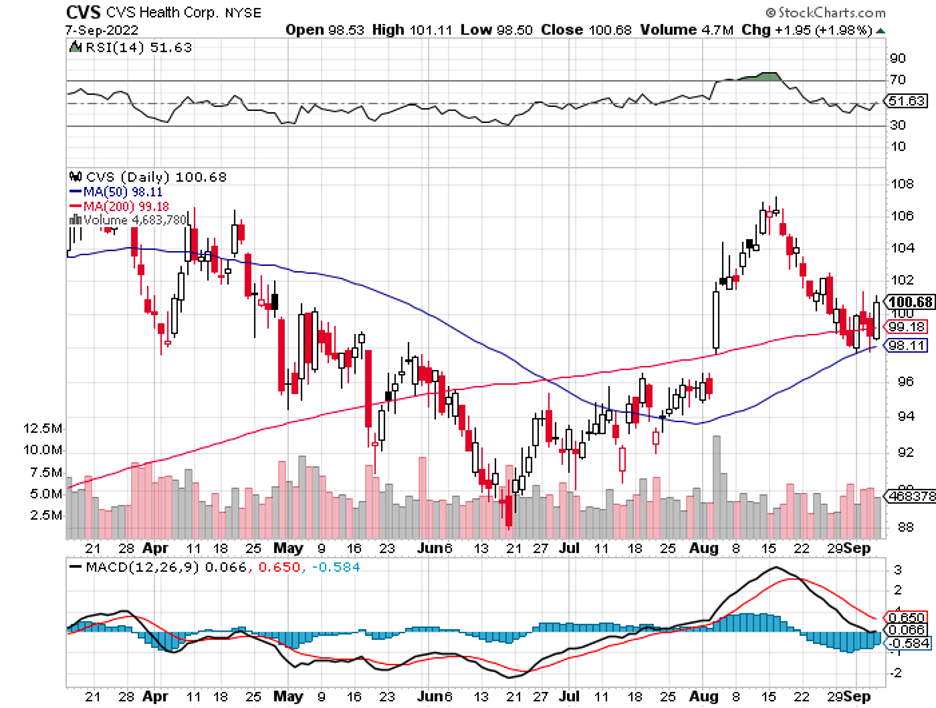
Mad Hedge Biotech & Healthcare Letter
June 1, 2021
Fiat Lux
FEATURED TRADE:
(AN UNDERRATED HEALTHCARE STOCK)
(UNH), (ANTM), (HUM)

Value investors on the lookout for stable stocks in the healthcare and insurance sectors should not miss out on a particular company that has consistently delivered strong performance over the years: UnitedHealth Group (UNH).
Despite its notable performance in the past 10 years and tangible plans that lead to more room for growth, UNH is still remarkably undervalued.
With the expanding reach of the COVID-19 vaccines and the promising prospects offered by Medicaid and Medicare expansion efforts, the future of this health insurance provider definitely looks bright.
In fact, this stock managed to weather the devastating effects of the COVID-19 pandemic and did pretty well in 2020.
Shares of this health insurance titan actually climbed 19%, beating the S&P 500 index.
What’s even more promising is that UNH appears to be doing better in 2021.
In its first-quarter earnings report, UNH recorded a 9% jump in its revenue for the first quarter of 2021 at $70.9 billion compared to the $64.4 billion reported in the same period in 2020.
In terms of its net income for the quarter, UNH raked in $4.9 billion compared to the $3.4 billion it reported last year.
This puts its earnings per share at $5.31, a notable bump from the $3.72 recorded in the same period a year ago and blowing past analyst estimates of $4.38 per share.
With a $388.73 billion market capitalization, UNH is easily one of the biggest companies in its field. In comparison, competitors like Anthem (ANTM) hold a market cap of $97.5 billion, while Humana (HUM) has $56.47 billion.
Leveraging its size and power, this healthcare giant has ventured into diversifying its portfolio to ensure consistent results amid the never-ending changes in the healthcare industry.
Looking at the numbers closely, UNH’s health insurance segment brought in the bulk of the revenue in the first quarter with $55.1 billion, up by 7.9% compared to last year.
Membership count also increased by over 1 million during this period, which could be primarily attributed to the strong growth of its Medicare Advantage program.
The addition of specialty services, like dental and vision insurance, also contributed to the sustained development of this segment.
Meanwhile, UNH’s Optum division saw a 10% increase in its revenue year-over-year to reach $36.4 billion.
Even its OptumHealth segment delivered a particularly strong performance, with its revenue jumping by 31% compared to the same period last year.
UNH’s technology services sector, OptumInsight, also experienced revenue growth to reach $20.8 billion this quarter.
Even UNH’s weakest link, its OptumRx sector or the pharmacy benefits management division, experienced a slight increase in its revenue to hit $21.6 billion year over year.
These numbers show how UNH is split into two major groups. One sector offers traditional insurance plans, while the other, Optum, offers pharmacy and doctor services.
In 2020, its insurance segment comprised 60% of UNH’s overall revenue, while Optum generated the remaining 40%.
This translated to $257 billion in revenue from the insurance plans and $103 billion generated by its Optum services division.
Considering that UNH appears to be performing better than originally projected, its earnings guidance for 2021 was adjusted to reflect the changes.
To date, the company estimates its adjusted earnings to be somewhere between $18.10 and $18.60 for each share.
UNH utilizes a balanced business approach, which covers both traditional services in the health insurance sector and a variety of innovative solutions courtesy of its Optum units.
So far, this strategy has paid off well in the long run. As we see the world go back to normal, it is expected that UNH would enjoy even more tailwinds in its favor.
UNH is a solid stock that deserves a spot in any value investor’s portfolio.
If the efforts to fight the COVID-19 pandemic prove to be successful this year, then UNH expects an even better performance in 2022.
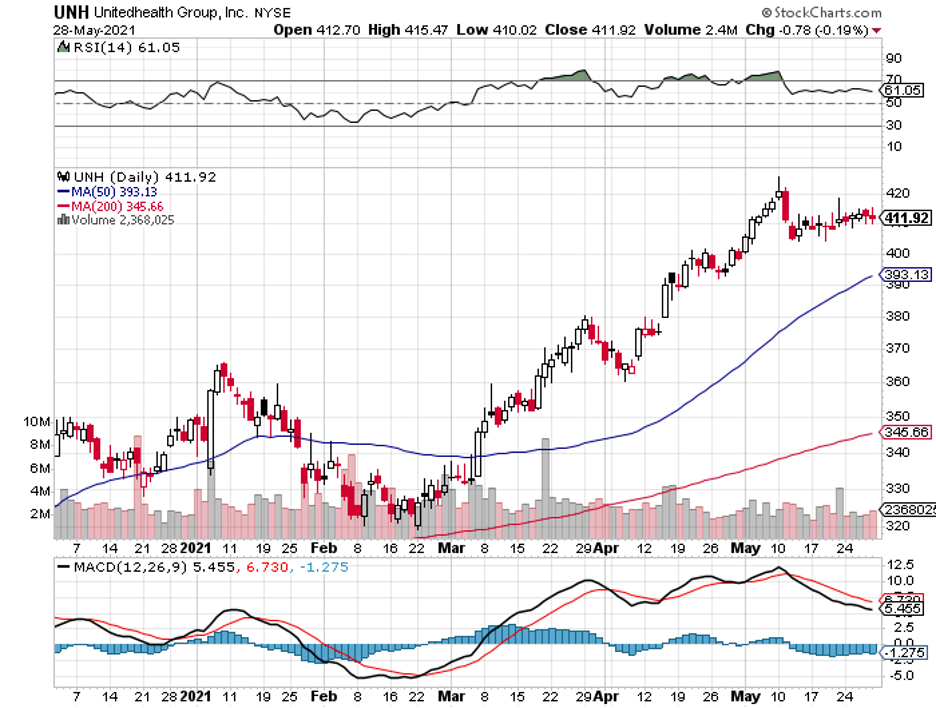
Legal Disclaimer
There is a very high degree of risk involved in trading. Past results are not indicative of future returns. MadHedgeFundTrader.com and all individuals affiliated with this site assume no responsibilities for your trading and investment results. The indicators, strategies, columns, articles and all other features are for educational purposes only and should not be construed as investment advice. Information for futures trading observations are obtained from sources believed to be reliable, but we do not warrant its completeness or accuracy, or warrant any results from the use of the information. Your use of the trading observations is entirely at your own risk and it is your sole responsibility to evaluate the accuracy, completeness and usefulness of the information. You must assess the risk of any trade with your broker and make your own independent decisions regarding any securities mentioned herein. Affiliates of MadHedgeFundTrader.com may have a position or effect transactions in the securities described herein (or options thereon) and/or otherwise employ trading strategies that may be consistent or inconsistent with the provided strategies.
This site uses cookies. By continuing to browse the site, you are agreeing to our use of cookies.
OKLearn moreWe may request cookies to be set on your device. We use cookies to let us know when you visit our websites, how you interact with us, to enrich your user experience, and to customize your relationship with our website.
Click on the different category headings to find out more. You can also change some of your preferences. Note that blocking some types of cookies may impact your experience on our websites and the services we are able to offer.
These cookies are strictly necessary to provide you with services available through our website and to use some of its features.
Because these cookies are strictly necessary to deliver the website, refuseing them will have impact how our site functions. You always can block or delete cookies by changing your browser settings and force blocking all cookies on this website. But this will always prompt you to accept/refuse cookies when revisiting our site.
We fully respect if you want to refuse cookies but to avoid asking you again and again kindly allow us to store a cookie for that. You are free to opt out any time or opt in for other cookies to get a better experience. If you refuse cookies we will remove all set cookies in our domain.
We provide you with a list of stored cookies on your computer in our domain so you can check what we stored. Due to security reasons we are not able to show or modify cookies from other domains. You can check these in your browser security settings.
These cookies collect information that is used either in aggregate form to help us understand how our website is being used or how effective our marketing campaigns are, or to help us customize our website and application for you in order to enhance your experience.
If you do not want that we track your visist to our site you can disable tracking in your browser here:
We also use different external services like Google Webfonts, Google Maps, and external Video providers. Since these providers may collect personal data like your IP address we allow you to block them here. Please be aware that this might heavily reduce the functionality and appearance of our site. Changes will take effect once you reload the page.
Google Webfont Settings:
Google Map Settings:
Vimeo and Youtube video embeds:
